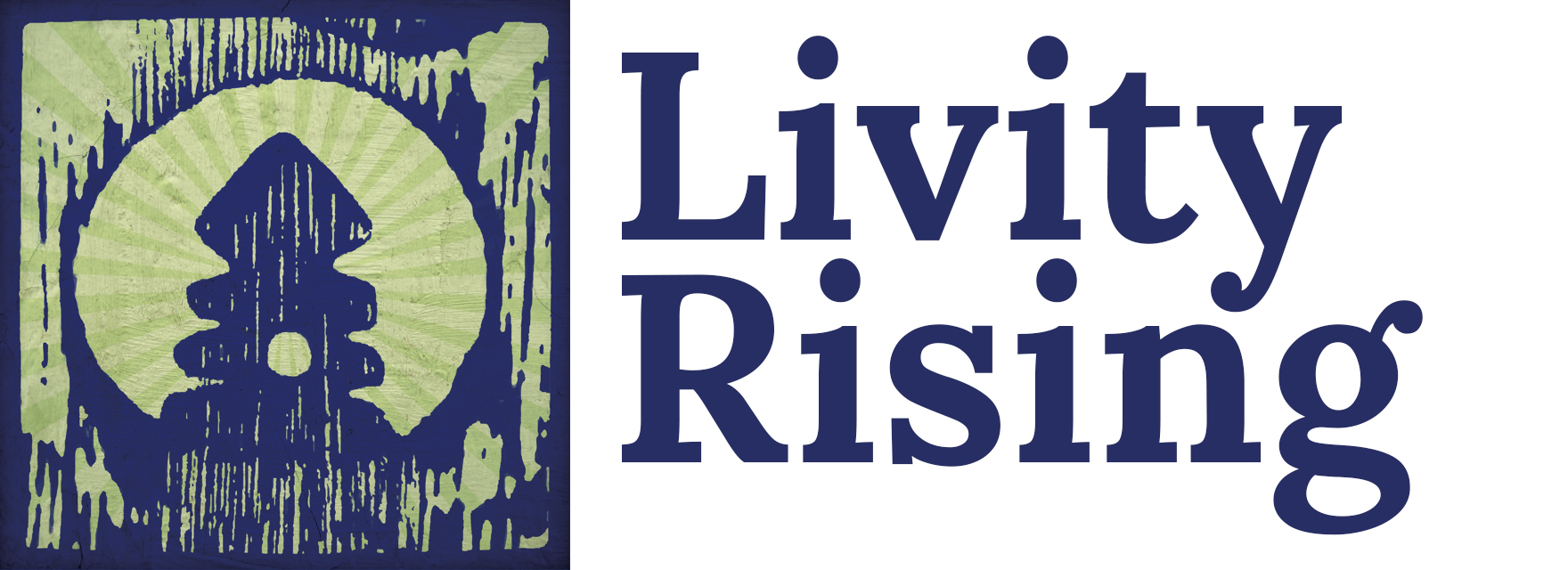Covid
Self-Care
Guide
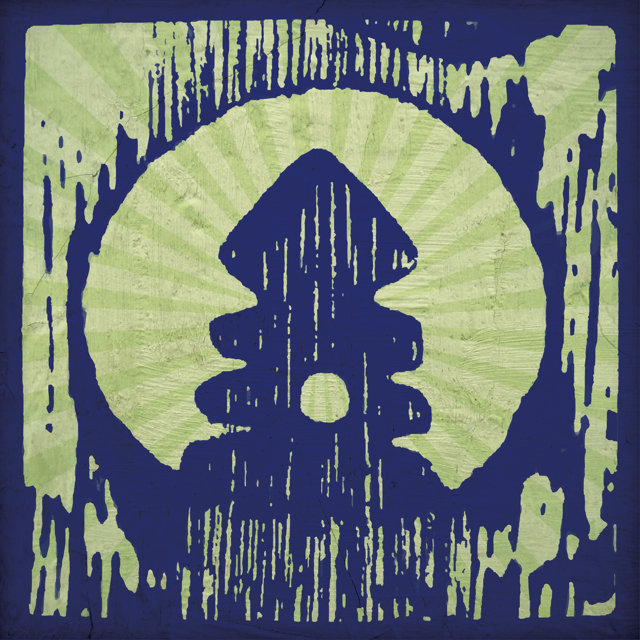
We are happy to share a Traditional Chinese Medicine (TCM) wellness guide which provides self-care techniques through acupressure, qigong, breathing practices, and TCM dietetics, created by former Livity Rising practitioner, Dr. Marissa Riojas, DAOM.
This booklet guide provides specific ways to incorporate TCM into your life. Use what resonates with you and serves you. The first article entitled The Guiding Principles of TCM and Self Care, will help you get a foundation in TCM theory, and therefore help you understand how to read this booklet. Enjoy!
If you have questions, please email us at info@livityrising.com
Booklet Contents:
(click the section description to scroll to each section)
The Guiding Principles of TCM and Self Care: Looking Through a TCM Lens
Self-Care List: TCM Daily Living Tips
Self-Care Tip: Stimulating the Vagus Nerve
Self-Care Tip: Acupressure for Immunity and Mental Health
Self-Care Tip: Qigong for Relaxation and Cleansing
Self-Care Tip: 6 Qigong Healing Sounds for the 5 Emotions
Self-Care List: TCM Dietetics for “Covid Season”
Notice:
Always consult a physician or acupuncturist before starting any new regimen: If you engage in these exercises and techniques, you agree that you do so at your own risk, and should consult a Physician or Acupuncturist to determine if these methods are right for you.
The Guiding Principles of TCM & Self-Care:
Looking Through a TCM Lens
By: Dr. Marissa Riojas, DAOM
According to TCM, we are constantly amidst change in a perpetual cycle of the interaction between yin and yang; this is life. Yang is immaterial, energy, movement, and fire. Yin is material, matter and substance, and water. To begin to understand Traditional Chinese Medicine, and thus the information in this guide, we can look at the four principles of the Yin-Yang relationship within the context of our present situation. Health and well-being are about maintaining equilibrium; balancing your yin and your yang as life around us and within us change.
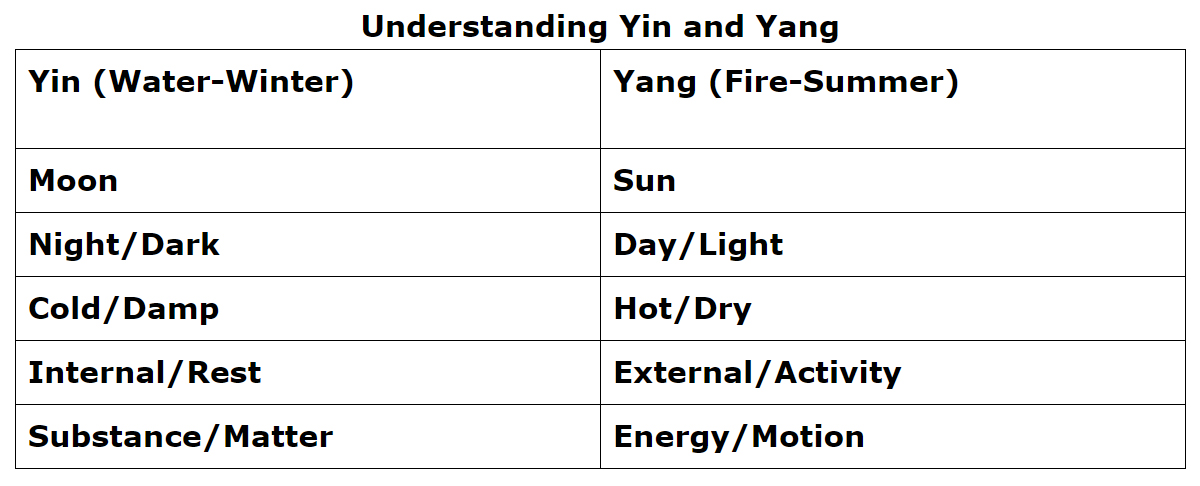
The Four Aspects of Yin and Yang:
1) Yin and Yang are Opposites
Yin and yang are opposites; however, being opposites means that they are relative to the other, and nothing is absolute or on its own. When we are very busy, barely have a moment to think, our “medicine” is to find ways to do the opposite; go inward and slow down. When we are in states of internalization, or physically underactive, our “medicine” is to go back outward, live in the body, and move. Your medicine right now is to nurture the opposite of whatever your current circumstances are in order to keep both in balance. If you are in shelter-in-place and barely moving, then find ways to move safely. If you are an essential worker and are always on the go, your medicine is to find those moments of rest, grounding, and pause throughout your day.
Self-Care Question: How can I use the idea of opposites throughout my day to stay more balanced?
2) Yin and Yang are Interdependent
“Day cannot come without night, and vice versa; there cannot be activity without rest, energy without matter or contraction without expansion” (Macioca, 2015). In order to expand or grow, it is necessary to contract and learn. This is the state we find ourselves in with our circumstances, a time for external life to contract. In understanding this principle, it is a fertile time for inner expansion. In summer when the natural world is at its most expressive, it can do so because we first have a winter where the natural world can go inward and regenerate. In order for a flower to blossom, a seed must enter soil; it is both contracting and expanding at the same time. Our “medicine” during this time is to consider how, like a seed, we can use both expansion and contraction to grow.
Self-Care Questions: How can I support further expansion physically, mentally, and emotionally during a time of contraction? How can I further support healthy contraction?
3) Yin and Yang are Mutually Consuming
Yin and yang are perpetually in a dance, adjusting to one another. When one goes out of balance it affects the other, and both try to adjust within the imbalance. When there is too much heat, the soil becomes dry, and if there is too much rain, the soil drowns. In our bodies, if we are too active (yang) it burns our internal moisture (yin). And likewise, if we are inactive and don’t move, substance can accumulate to the point of drowning everything out. Your “medicine” right now is adjusting your yin and yang in your lifestyle as appropriate (this guide will give you concrete ways to do that). Keep in mind that Covid-19 is a Yin (damp) pathogen.
Self-Care Question: What am I doing too much of that is causing deficiency, and what I am doing too little of that is causing excess?
4) Yin and Yang Intertransform
Yin and yang can actually transform into each other once they have reached their peak of exhaustion. An example in nature is that the sun bursts forward into day (yang) after reaching the peak of night (yin). When we exercise intensely and start to heat up (yang), our body self-regulates with sweat (yin). Ultimate yang leads to yin, and ultimate yin leads to yang. This means that yang can only reach a certain peak until it inevitably becomes the other, and vice versa. Maybe you lounged all day watching Netflix (inactivity) and now you cannot sleep (hyperactivity), or you drank too much alcohol (euphoria) and now you have a major hang-over (dysphoria). Your “medicine” during this time is to do things in moderation as best you can and as best circumstances will allow.
Self-Care Question: How can I transform my lifestyle with mindful moderation?
The principles of yin and yang stem from the core TCM principle of homeostasis, or equilibrium and balance. Therefore, yin and yang principles do not stem from a view of good or bad; there is only balance. I find that if I let go of the judgement of my yin and yang imbalances, or of my lifestyle choices, I am able to take charge of what needs to be adjusted in my life with honesty and precision. If we choose to see yin and yang as a dance, always needing to adjust to our partner (life), then we can have compassion for the process, and make the necessary adjustments back to better balance.
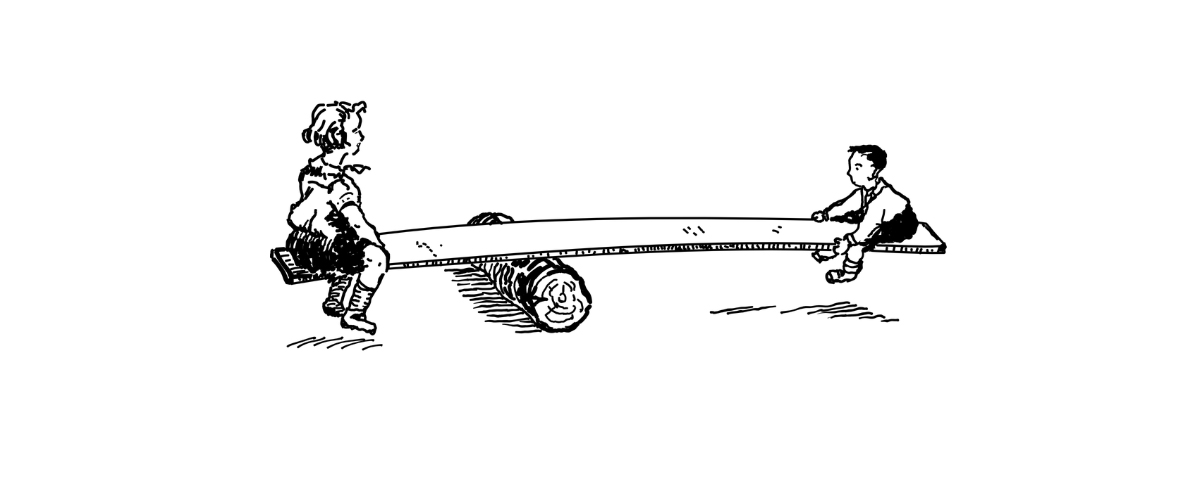
Self-Care List
Daily Practices: TCM During “Covid Season”
By: Dr. Marissa Riojas, DAOM
1) Breathe! Making your exhale longer than your inhale calms the nervous system. So if you breathe in for 4 counts, breathe out for 6-8 counts.
2) To tonify your lungs, eat things like pine nuts, almonds, pears, and apples.
3) To boost your immune system, cook with spices like cinnamon, ginger, perilla leaf, mint, citrus peel, clove, and scallions/chives.
4) If you are feeling a bit ill, cook with spices like: ginger, turmeric, thyme, and oregano.
5) Limit your intake of “phlegmy” foods, such as gluten, dairy, sugar, cold/icy foods, and alcohol.
6) Opt for water-based cooking methods such as steaming, poaching, slow cooking rather than high temperature cooking like frying, broiling, toasting, grilling. This will limit Advanced Glycination End products (AGE’s) into your system that cause oxidative stress and inflammation (See dietetics list at end).
7) Dry brush your skin to improve lymph movement and boost your body’s ability to detox naturally. Or lightly bounce your body while on your toes throughout the day to help your lymph system move.
8) Roll a tennis ball behind your neck, at the level where the skull meets the neck. Roll the tender spots for 5-10 minutes a day. It will help with pain, headaches, mental health, and immunity (See Occipital Massage tutorial).
9) Singing, chanting, humming, and gargling are great ways to relax your nervous system. The vibration stimulates the Vagus nerve, the longest nerve in the body that regulates immunity and mental health.
10) Tap on your kidneys by placing both hands behind your back with each hand in the shape of a loose “C” shape. This aids with strengthening your overall health and well-being. Do this whenever you feel tired, need to reset yourself, or have been standing or sitting for too long.
11) With your finger tips, tap on your chest anywhere between the collarbone and the breast. There are many emotional level points in this area. Find any sore spots, and tap lightly with compassion while breathing steadily. Imagine those sore spots dispersing with each tap. Finish by placing both hands on your heart and breathing in with a longer exhale.
12) Do the Qigong move “Pulling Down the Heavens” by watching the video link in this booklet. It will help with mental and emotional well-being by relaxing the nervous system, and cleansing your energetic body.
13) Take up a Taiqi or Qigong practice by watching free online videos at home, or check out your local studios to see if online classes are offered.
14) Smile and Laugh. Laughter stimulates the Vagus nerve through vibration. Smiling and seeing smiling faces is also linked to Vagus nerve regulation in a mechanism called the Face-Heart Connection (Porges, 2011, p. 125).
15) Most importantly, practice compassion (loving kindness) as often as you can through thought, words, and actions. Being kind to self and others stimulates the Vagus nerve as it is a key component in our social engagement systems (Berglund, 2017). That’s why we feel so good when we do something for another person.
Self-Care Tip
Stimulating Your Vagus Nerve
By: Dr. Marissa Riojas, DAOM
The longest nerve in your body, called the Vagus Nerve, has a big impact on your nervous system, and therefore your immunity and mental health. So a way to improve your overall health is to stimulate your Vagus nerve, as it literally touches many organ systems and also communicates with the brain. I would like to show you acupressure points that stimulate the Vagus nerve and helps you with immunity and mental health. Here are a few tips:
1) Touch Your Ears
A great way to start stimulating the Vagus nerve is to start with an ear massage. I naturally give myself ear massages “accidentally” throughout my day when I’m stressed. I catch myself with my hand on my ears as my mind starts to worry. Rather than seeing this as a nervous tic, it is the wisdom of the body trying to self-regulate. Not only does the Vagus nerve travel to the ear, but there are many acupressure points on the ear that aid the entire body. Help your body along by stopping for a few seconds or a few minutes to self-soothe.
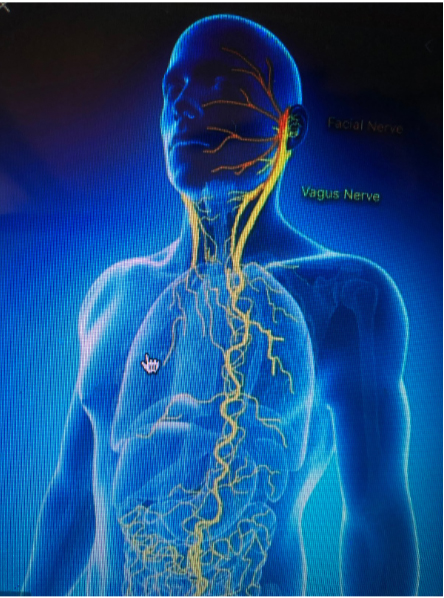
Ear Self-Massage Tutorial:
The Vagus nerve runs through the space between the ear and the face. I start by rubbing that line between the face and the ear with my middle finger, and my index finger behind the ear. Rub up and down gently. Next, rub the ear lobe with the index finger, and the backside with the thumb. Move up the outer ridge of the ear until you get to the top of the ear. Then use the entire index finger to gently pull the ear from the head making sure to touch as many parts of the ear as you can. Then, take your index finger or pinky and lightly touch all the grooves of the ear, massaging firmly but gently. Make sure to get all the little crevices of the ear. Do not stick your finger in your ear canal.

Vagus nerve ear position
2) Use Voice Vibration
When stressed, you may find yourself sighing a lot or grunting, holding your chest, grabbing your neck, or placing your fingers on your forehead when frustrated. These are other ways your body might be trying to help you self-regulate. Again, rather than see these are nervous tics, stop and let your body self-soothe. The Vagus nerve travels into the neck and shoulder area, down into the chest and into the abdomen. The nerve gets stimulated by vibratory sounds. Sighing, humming, singing, chanting, and gargling are ways that you can stimulate the Vagus nerve. The more guttural the sound, the better. No wonder you sigh so much when stressed…your body is wise and knows what it needs. My favorite practice is to sing karaoke until I feel a sense of joy and calm.

3) Use Acupressure around the occiput and neck
A great point for both immunity and mental health is located at the base of the skull (occiput). This area stimulates the Vagus nerve as the nerve travels through this area.
Occipital Acupressure Tutorial:
You can do this for 5-10 minutes as often as you like daily.
GallBladder 20 is a point used for high blood pressure, nervousness, headaches, and is an area used often when someone is sick or is trying to prevent sickness. It is located in a corner created by the neck muscles next to the spine and the edge of the skull.
Simply place your hands behind your ears at the level of the ears, like you are clasping your hands behind your head. Drop your thumbs down to your neck.
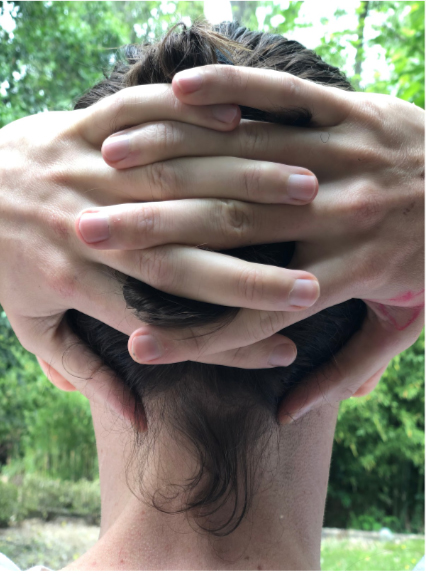
Your hands fall into a dip or crevice on each side. From this position and to ensure we are in the correct place, move your thumbs upward until you can feel the edge of the skull, then scoot over toward the spine until the muscle blocks your way. In this corner, press in and up, in the direction of the opposite eye (as if going through your head). Your right thumb should be pressing in the direction of your left eye, and the left thumb should be pressing in the direction of your right. Hold this for 9 seconds. Relax your thumbs, and press in again for 9 seconds.
Now in the same position with your thumbs, move horizontally in the space between the edge of the skull and beginning of the neck. This is called the occipital area. Massage your occiput with your thumbs as you move horizontally. You may come across some sore points as you go outward, that’s ok and you may decide to keep massaging these areas. Doing this little self-massage an hour before bedtime will help your body start to relax. It also aids neck pain and headaches. This is an area that is safe to self-massage, or to use with a tennis ball to roll over while you are lying on the floor.
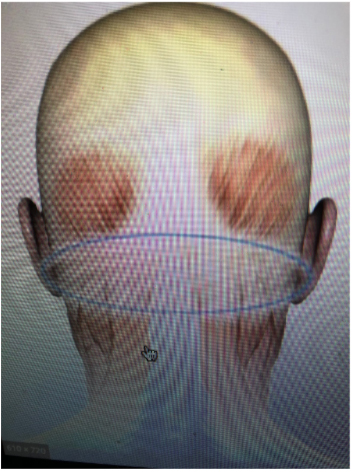
Anmian is an extra point used in TCM to aid with sleep issues, such as insomnia. It helps promote relaxation. It is located about an inch out from GB20 on the same horizontal line. Anmian is a point that stimulates the Vagus nerve because of the proximity to the nerve. To ensure you are in the correct place, it is midway between the back of the earlobe and GB20. It most likely will be tender. Press in with your thumb or roll over with a tennis ball while lying on the floor.
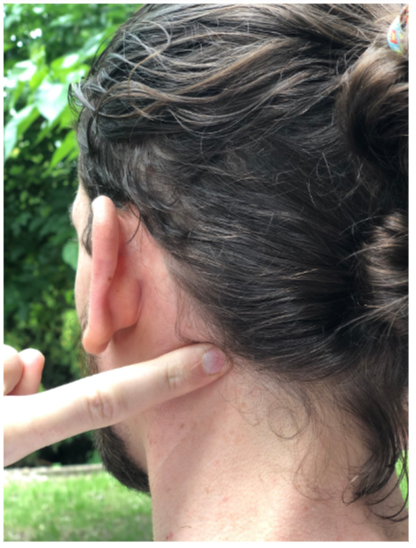
Gallbladder 21 is another great point for both immunity and keeping energy from rising to the head. It is great for headaches, anxiety, dizziness, high blood pressure, and tight neck and shoulders. It is located at the highest point on the top of the shoulder and is usually incredibly tight and sore. Press the point by clamping down with your opposite thumb and index finger, like a big pinch. It is also a great point to have someone press in with a thumb or with an elbow. Hold pressure for 9 seconds and breathe through the discomfort. You may feel a radiating pattern refer to your head or down your shoulder when you push down. This is normal and signifies that not only are you on the right spot, but you are activating the release of the muscle. This trigger point technique of applying deep pressure helps to relax the shoulder and neck muscles. If this is too intense for you, simply pluck the point with your opposite thumb. If it is tight, it may actually feel like plucking a guitar string. It is a great point if you work all day on a computer.
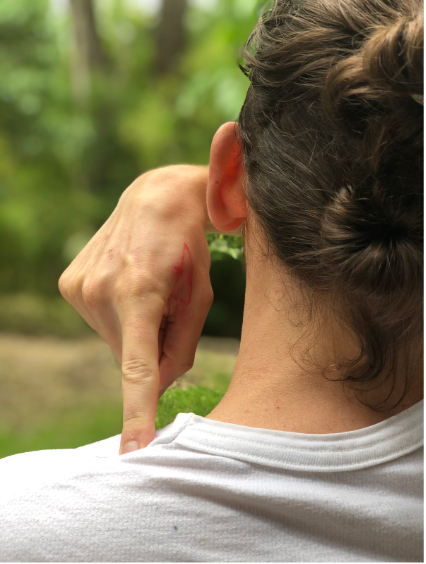
Self-Care Regimen
Acupressure for Immunity and Mental Health
By: Dr. Marissa Riojas, DAOM
In Traditional Chinese Medicine, acupuncture assists the body by regulating many meridians that flow throughout the body. These meridians or channels can be stimulated with acupressure to benefit overall health. Each point has a specific function and energetic quality. The points can be plucked or pressed repetitively for 5-10 minutes on each side.
Large Intestine and Lung Points: LI4
The Large Intestine channel (LI) is a channel used for illness, pain, and digestion; anything that has the potential to go into excess or accumulation. It also works on the emotional aspect of letting go or surrender, and clearing out what doesn’t serve us. The Large Intestine pairs with the Lung, which provides energy and protection to the entire body. On an emotional level, the Lung meridian works with grief and sorrow.
Large Intestine 4 (LI4):
Put your hand in front of you, palm down. Spread your thumb from the index finger, and touch the webbing in between the thumb and index finger. The point is located in this triangular area along the index finger bone when the muscles of the hand are relaxed. It is found midway of the bone. It is usually sensitive to the touch and may even feel swollen. Use your thumb to pluck this point away from you toward the bone, like you are plucking a guitar string with your thumb. Seek out the sore spot.
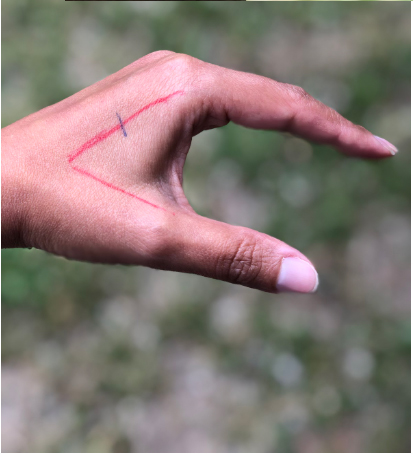
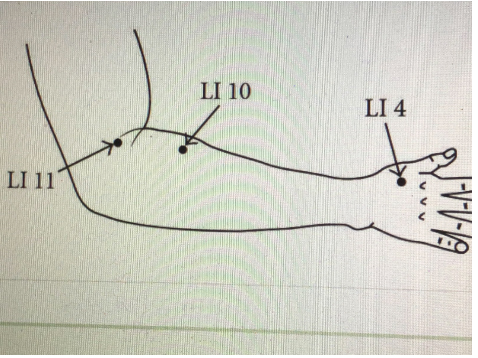
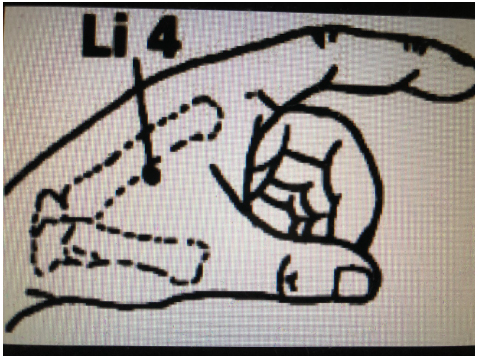
Large Intestine 11 (LI11):
With your elbow bent in front of you, look down at the crease of the elbow and notice where the crease line ends. The point is located here. To keep the arm steady, use your opposite hand to grab the elbow, and using that thumb to pluck in the direction away from the body. Seek out the sore spot.
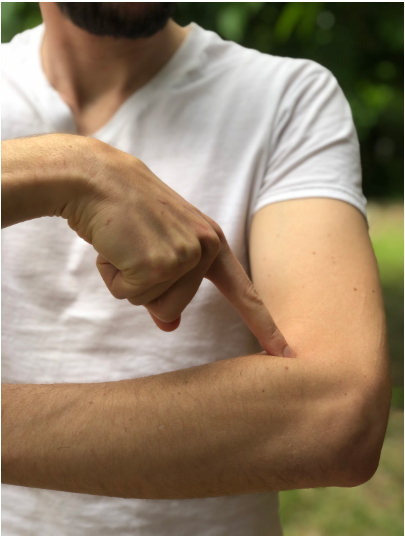
Lung 10 (LU10):
This is a good point to use if you are already sick. Look at the palm of your hand. Under the thumb, there is a mound of muscle called the thenar eminence. Visually cut the mound in half horizontally, on that midway point along the outer edge of the thenar eminence, press to find the bone with your thumb. Press in toward the bone. It most likely will be tender to pressure. Hold the pressure for 9 seconds. Repeat.
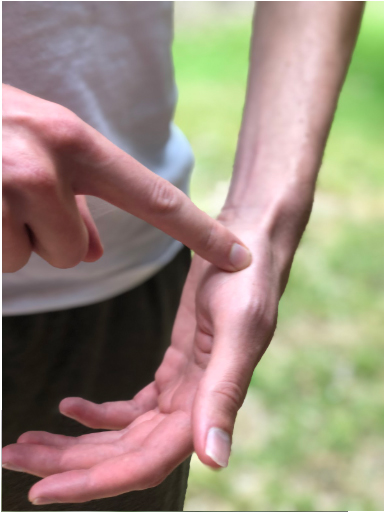
Stomach Point (ST36):
The point ST36 is one of my favorite points and most used in acupuncture. It is called “leg 3 miles” because the Daoist monks back in ancient times used to rub this point on long arduous journeys as it was said that after rubbing this point, they could walk three more miles before they called it a day. It is a wonderful point to use if you are feeling run down, stressed, overworked, and fatigued. On an emotional level it is a great point for strengthening your inner resources so that you can continue on your arduous journey. It is great for boosting immunity, fighting infections when they first start and fortifying the immune system through the connection with the gut and the lungs. And as we know from modern science, the gut has a lot to do with overall well-being and immunity. It also works with nausea, vomiting, and digestive disorder.
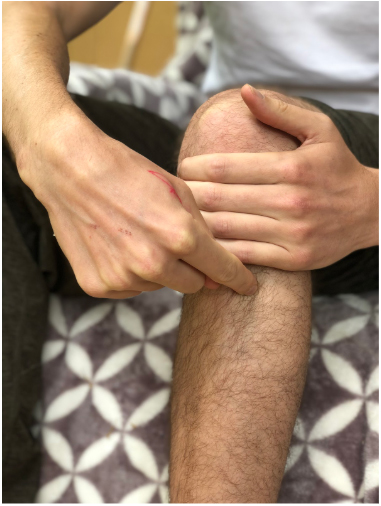
Stomach Point (ST36):
This point should be found sitting down. Look down at your knees while they are bent (seated position). Two dimples on each side of the knee form, these are called “calf’s nose” because they look like the nostrils of a cow’s nose. Place four fingers across your knee in the middle of both calf’s nostrils. On the lateral aspect of your leg (the side nearest the outside of your body), find a tender point right under your four fingers, along the lateral edge of the tibia bone (not on the bone). Once you find it, you can take your four fingers away and press around to find a tender spot. Press in with your thumb or use a massage wand or the end of a pencil (eraser side) to press into the point. It most likely will be sore on one side especially. Press and hold for 9 seconds, repeat.
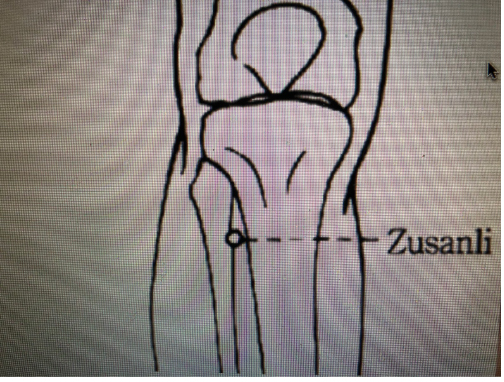
Extra Point: Yintang
Another Great Point is Yintang. Yintang is located where the third eye is, on the forehead. On an energetic level, it is used for issues of consciousness and spiritual growth. It is also an area used for anxiety, sleeping problems, headaches, and any other issue where there is too much energy in the head. It is an area that animal mothers lick on their babies to comfort and cleanse them. This point works similarly to calm the spirit.
Yintang:
Look in the mirror. Visualize a line created if your eyebrows were to go all the way across like a line or unibrow. In the middle of that line is where the point is located. Another way to find it is to find the point at the intersection between the midline of the nose (bridge of the nose) and the inner edge of the eyebrow. Tap gently with your middle finger. If the point is tight or it feels like there is a lot of tension there, you can gently pull up on the skin there with your thumb and index finger, and hold.
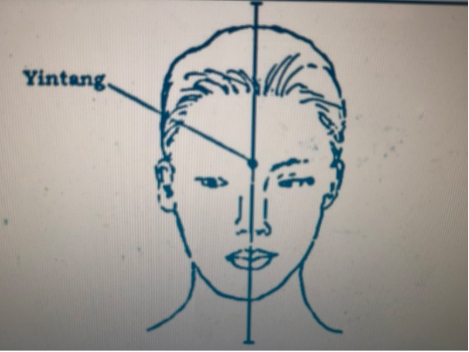
Self-Care Tip
Qigong for Relaxation and Cleansing
“Pulling Down the Heavens”
By: Dr. Marissa Riojas, DAOM
First, let’s talk about the link between immunity and mental health. Research studies have shown a correlation between high stress and lowered immunity, so an important aspect of a strong immune system is stress management. Both your nervous system and your mental health are supported by the longest nerve in the body, called the Vagus Nerve. If you can keep this nerve healthy, a big part of your immunity, mental health, and overall well-being are supported.
Pulling Down the Heavens:
My favorite Qigong Exercise is called Pulling Down the Heavens, or Drawing Down the Heavens. It is a wonderful way of stimulating your Vagus nerve, thus calming your entire system. It is really grounding, aids with anxiety, and is also very cleansing. This exercise acts as a reset button for the physical and energetic bodies.
Qigong Stance:
First you will want to get in a Qigong stance, which is to stand with legs shoulder width apart. Make sure your pelvis is stacked above your legs, and not jutting back. Then stack your shoulders above your pelvis, not forward rolled. Stack your neck above your shoulders, pushing the chin back slightly (not jutting out). Sink slightly into the stance effortlessly, with knees relaxed and slightly bent.
Next, raise your arms slightly in front of you so that your underarm is able to breathe. If you feel yourself tensing up, relax into the pose a bit more. You are stable but relaxed. This is the Qigong stance.
Qigong Tutorial:
On an inhale, we are going to lift the arms steadily, this is gathering the earth. At around shoulder height the arms will naturally twist, leaving the palms facing upward toward the sky. Then on the exhale, slowly pull down the heavens by descending your arms in front of you. You can do this by visualizing that you are gathering energy from the earth on the inhale, and descending energy from the heavens as you exhale. I imagine my palms like two giant magnets, pulling earth up and heaven down into myself.
Let’s do that again. In Qigong stance, raise the earth (arms raising overhead). As you pull down the heavens (arms coming down), I like to visualize a healing bright light scanning my physical and energetic bodies, evaporating anything that doesn’t belong there. As my arms are lifting, I also imagine potent earth energy filling me up and tonifying me.
Keep in mind that pulling down the heavens slowly upon the exhale stimulates the vagus nerve and relaxes the nervous system. The key is a longer exhale than the inhale. If you wish, you can do this type of breathing without the qigong exercise, on its own…a longer inhale than an exhale.
You can do these techniques daily anytime you feel anxious or stressed, or feel like you need to reset yourself. They are great to do upon waking up to kick start your day, after work to cleanse your energetic body, and before bed to prepare for relaxation. Do them until you feel a state of calm come over you or when your breathing has evened out. Return to it whenever you need.
Self-Care Tip
The 6 Qigong Healing Sounds for the 5 Emotions
By: Dr. Marissa Riojas, DAOM
In Traditional Chinese Medicine, the five main organs belong to an element and have an emotion attributed to each. When we feel a certain emotion, it is considered tied to that specific energetic organ system. When we feel emotions in excess, it could signify imbalance in that element, which can eventually drain or stagnate the organ system. In TCM, the 5 emotions are considered part of a healthy person, and TCM does not judge the emotions as good or bad. They are simply energy. There are ways to transform the energy of emotion by channeling it into sound. At its core, energy is simply vibration, and vibration as sound can literally break glass. Vibration works in the same way in the body, breaking through stagnation. Energy doesn’t disappear; it gets transformed or stored. Allowing the emotion to fully express itself through a sound, is neither ignoring it or storing it, it’s transforming it. The emotion gets its full expression through sound, and does not cause harm to ourselves or others.

The Qigong sounds move and transform emotion. The sounds work by resonating with its paired element and organ. The sound is both the organ’s lullaby, tonifying and calming, and the organ’s blaring alarm clock, jarring it awake and getting it moving.
You can use the healing sounds to move through difficult emotions that come your way, or to work through emotions that have been bottled up. These are sounds that you can do throughout your day and make a part of your lifestyle to manage emotions and self-regulate. They are meant to be done repetitively and habitually, and can be learned with medical qigong movements for maximum potency (See qigong sounds with movement video).
How to make the 6 sounds: practice here
The 6 Sounds for 5 Emotions Tutorial:
If you want to incorporate the qigong movements with these sounds instead of simply breathing, please watch the qigong video above.
When you are feeling stressed, anxious, hyperactive, your heart is beating out of your chest, or you get a tight chest from stress, place your hands on your heart, and do a 4 count inhale, with a, 7 or 8 count exhale. Then, inhale, and on the entire exhale make the sound: Haaah (the heart sound). Visualize those emotions releasing from you with that sound, like a big sigh. Do as often as you need.
When you feel sad, depressed, or full of grief, do a 4 count inhale, with a 7 or 8 count exhale. Then, inhale and on the entire exhale make the sound: Ssssss (the lung sound). Visualize those emotions releasing from you with that sound, like a tea kettle hissing. Do as often as you need
When you feel angry, frustrated, irritated, pent up, or “stuck”: do a 4 count inhale, with a 7 or 8 count exhale. Then, inhale and on the entire exhale make the sound: Shhhhh or Shooooo (the liver sounds). Visualize those emotions releasing from you with that sound, like a pressure cooker releasing steam. Do as often as you need.
When you feel worried, can’t stop thinking, and are obsessing or ruminating: do a 4 count inhale, with a 7 or 8 count exhale. Then, inhale and on the entire exhale make the sound: Hoooooo or Whoooo (the Spleen sounds). Visualize those emotions releasing from you with that sound, like a train horn clearing the way. Do as often as you need.
When you feel fearful, overwhelmed by emotion, or feeling like you are drowning in overwhelm and emotion: do a 4 count inhale, with a 7 or 8 count exhale. Then, inhale and on the entire exhale make the sound: Chu-ayyyy or Chreeeeee (the kidney sounds)
When you have gone through the 5 emotions, you can finish by balancing our and integrating your energy with the sound: Heeee (the san jiao sound). It is like a wave washing over you to reset things.
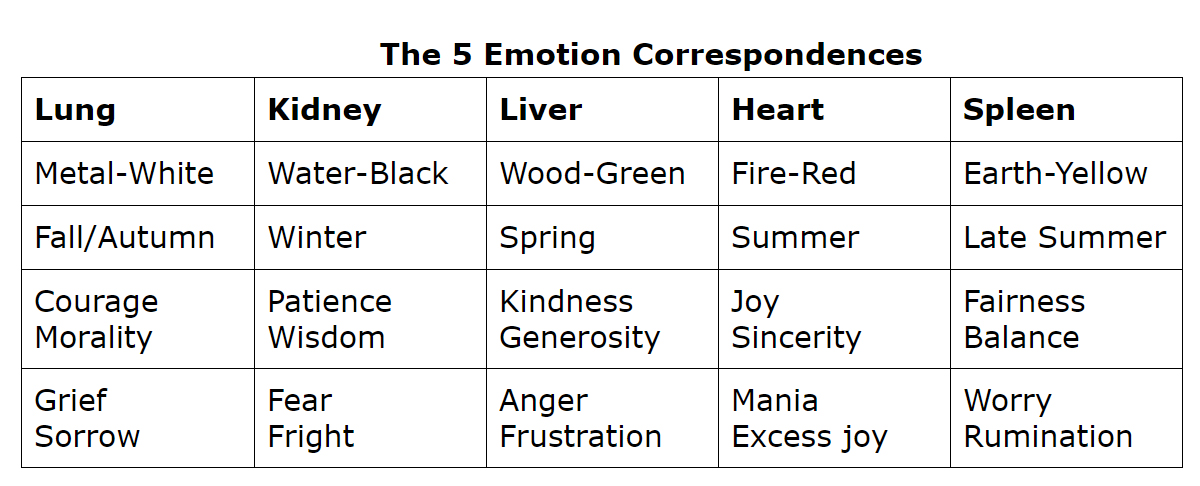
Self-Care List
TCM Dietetics During “Covid Season”
By: Dr. Marissa Riojas, DAOM
During this unprecedented time, we are challenged to adapt to new lifestyles and new norms in a short amount of time in order to meet the need. We must allow our bodies to adapt as our circumstances have changed. Our diet should account for these changes, as food can be our medicine. At this present time, we are all in need of healthier immune systems, accounting for lessened activity, and the need to keep the lungs and digestion healthy. Realizing that all of our circumstances are different right now, apply as many or as few of these tips as you find helpful. Here are some tips according to Traditional Chinese Medicine dietetics and energetics in order to prepare your body for “Covid Season.”
*The information below is based on the work of Andrew Sterman, TCM Dietitian.
1) TCM believes food is medicine
• Covid-19 is a damp/phlegm presentation in TCM, and eating damp or phlegmy foods might not be beneficial to health and prevention right now. This includes: dairy, sugar (this includes too much fruit), gluten, cold/icy foods
• Eat a “Clear Meal”, or foods that are easy to digest. Some general foods in this category include: root veggies, greens, aromatic spices, soups, porridges, steamed rice.
• In TCM, grains and rice (organic/non gmo) are not considered to be harmful in their most basic state (unprocessed), but always listen to your sensitivities foremost. By grains we mean the whole kernel that has been pre-soaked and cooked (See grains list at the end).
2) Eat to tonify your system, by nourishing your qi and fluids
• Stay hydrated and well rested. If your qi (energy) is low, so is your immunity. If your stress is high, your immunity takes a hit. Over-eating also uses a lot of qi. Rest and cultivate good sleeping and eating habits. All these things conserve your qi.
• Water is cleansing, but fats/oils/broths are hydrating (Sterman, 2020). Eat enough healthy fats, oils, and bone broths. Also recognize that carbonated (bubbled) beverages are dehydrating in nature…sorry seltzer water and soda.
• Drink 1-2 glasses of water first thing in the morning, do not use flavors such as lemon (don’t want to make your body think you are processing food)
• Eat a “wet breakfast” that nourishes your fluids, such as porridges and congees (See Porridge/Congee link at the end).
Example: I make my wet breakfast of organic rolled oats (oatmeal) every morning in my rice cooker. I add raisins, pumpkin seeds, blueberries, cinnamon, cardamom, ginger, and a bit of maple syrup.
• Eat homemade soups that are easy to digest and moistening, such as chicken and rice, corn soup, squash soup, lentil soup, miso soup. Refrain from using creams or milk in soups; should be broth or vegetable based.
3) Use spices that “Open the Exterior” (doesn’t allow pathogens to enter the body)
• These spices can be used in cooking: scallions and chives (do not use onion as it can be too drying), cinnamon, ginger, perilla leaf, mint, orange peel, clove.
• If already sick, consider using these in cooking: ginger, turmeric, garlic, mint. Thyme and oregano also, but not always beneficial to use these in excess or as supplements as they can be drying.
4) Keep your system moving
• Prevent and treat constipation or food stagnation (when food sitting like a brick or not feeling hungry for days after eating big meal) with aromatic seeds and spices such as: fennel, caraway seed, cumin, star anise, ginger, turmeric, garlic, mint, perilla leaf, and clove and nutmeg in smaller amounts.
• Avoid dairy, sugar, gluten when constipated. Gluten is literally like food glue (sticky/phlegmy), so keep that in mind.
• Recognize that healthy grains (whole kernel cooked) aid in peristalsis (gut motility) and aid digestion.
• Foods that work on the Lung and Large intestine dynamic (strengthening while moving things along) are: seaweeds, mushrooms, apples, pears, almonds, hazelnuts, pine nuts, root veggies, pumpkin seeds, chia seeds.
• Do light to moderate exercise every day, to keep your meridians and system from stagnating. Move your qi!
• Start dry-brushing your skin every day, to improve detoxification, lymph drainage, and improve immunity
5) Build Your Blood for Better Immunity
Covid-19 seems to be able to get to the blood level of TCM theory rather quickly (rashes, cardiovascular issues, strokes, etc.), so keeping your blood strong is a way to defend against easy invasion into deeper levels.
• Eat a variety of foods, not just meat, such as: beets, sweet potato, butternut squash, cherries, dandelion greens, broccoli, dates, rice (helps body build blood)
6) Transform Phlegm and Prevent Phlegm
• In cooking use: ginger, rosemary, thyme, tarragon, sage.
• Use gluten free whole grains (See list at end) if you tend to be phlegmy, or stay away from wheat altogether at this time as it is high in gluten, and therefore very “phlegmy.”
• Tonify the lungs by eating: pears, pine nuts, almonds, seaweeds
• Refrain from drinking alcohol right now, as it is essentially “damp-heat” ingested. In TCM, damp can be a precursor to phlegm.
• Reduce your damp food intake: dairy, sugar, alcohol, gluten, cold raw food, etc.
(There’s a reason why singers don’t eat or drink dairy before a show…hello phlegm!)
7) Limit your AGE (Advanced Glycination End Product) Intake
AGE’s cause high amounts of oxidative stress and inflammation, and those with chronic health issues such as diabetes might benefit from watching their AGE intake at this time.
• Reduce AGE intake by not using high-temp methods of cooking such as frying, grilling, toasting, broiling.
Ex.) fried egg (1240 kU/I), scrambled egg (75 kU/I)
Ex.) grilled chicken (5200 kU/I), poached chicken (1000 kU/I)
• Use water-based cooking methods such as steaming, stewing, poaching, braising, slow cookers work great!
• Foods high in AGE’s: red meat, creams/cream cheese, margarine, mayo, cheese, processed grains (crackers, cookies, etc.)
• Foods low in AGE’s: fish, eggs, legumes, boiled grains such as rice, oatmeal (not instant), porridges
Further Dietetics Resources:
Grains List:
By grains, we mean the whole kernel cooked, not necessarily grain flours. Even if a package says “whole grains” they are most likely mixed with refined grains. This occurs a lot with bread, crackers, cookies, etc. These tend to alter blood sugar, and provide little nutritional value.
Here is a list of grains that are easier to digest, have medicinal properties, and some of which are gluten free. They are all good to use for porridges or congees.
• Long grain rice (not instant or short grain rice), millet, quinoa, amaranth, buckwheat, farrow, teff, oats (not instant), barley, grits, polenta.
• It is Important that these grains are organic and non-GMO, and in their whole state
• Gluten free grains: Amaranth, Rice-long grain best, Buckwheat, Cornmeal, Polenta, Grits, Millet, Quinoa, Teff, Pure Oats
*Note: Oats can get contaminated with gluten from a processing facility with wheat, rolled oats are easier on the digestion and more moistening than steel-cut.
*Note: Grains and rice (not oats) should be soaked overnight
TCM Dietetics Theory and Recipes:
Andrew Sterman’s info and recipes: Congee/Porridge Information
He also has two wonderful books on TCM dietetics, or Energetic Eating (both theory and recipes):
Citations:
Berglund, Christopher. (2017, May 30). Kindness Towards Oneself and Others Tones Your Vagus Nerve. In Psychology Today. Retrieved from: https://www.psychologytoday.com/us/blog/the-athletes-way/201705/kindness-towards-oneself-and-others-tones-your-vagus-nerve
Brown, Mary J. (2019, October 22). What are Advanced Glycination End Products (AGE’s). Retrieved from
https://www.healthline.com/nutrition/advanced-glycation-end-products#low–age-diets.
Fatir, Amir. (2020, May 15). Six Healing Sounds. Mantak Chia Universal Healing Tao. Retrieved from:
https://www.mantakchia.com/six-healing-sounds/
Li, Peilin. (2020, April 29). Acupressure to Enhance Immunity [webinar]. In Net of Knowledge Webinar Series. Retrieved from
https://netofknowledge.com/MyKnowledge/MyEvents
Loffree, Nick. (2020, April 20). 6 Healing Sounds-Liu Zi Jue- Taoist Meditation in Motion for Inflammation Stress and Illness. Nick Loffree: Health and Fitness. Retrieved from:
https://www.youtube.com/watch?v=VQzXaqP3r4o&t=1103s
Macioca, G. The Foundations of Chinese Medicine. 2015. Elsevier: New York.
Maguire, Jessica. (2020, April 27). Vagus Nerve Master Class [webinar]. Retrieved from
https://www.jessicamaguire.com/vagus-nerve-anxiety-treatment
Porges, Stephen W. The Polyvagal Theory: Neurological Foundations of Emotions, Attachment, Communication, Self-Regulation. 2011. W.W Norton & Company: New York.
Sterman, Andrew. (2020, April 6). Dietary Support for Wei Qi for Covid-19 Prevention and Maintenance [webinar]. In Net of Knowledge Webinar Series. Retrieved from
https://netofknowledge.com/MyKnowledge/MyEvents
Twicken, D. (2011, Nov). Medical Qi Gong and Emotions. Acupuncture Today, 12(11). Retrieved from https://www.acupuncturetoday.com/mpacms/at/article.php?id=32483.
Yoqi Yoga and Qigong. (2017, July 13). Drawing Down the Heavens Tutorial. [Video file]. Retrieved from

Pay It Forward!
Monetary gifts and donations are greatly appreciated and support the plethora of free wellness services we provide to those in need.
Venmo:
